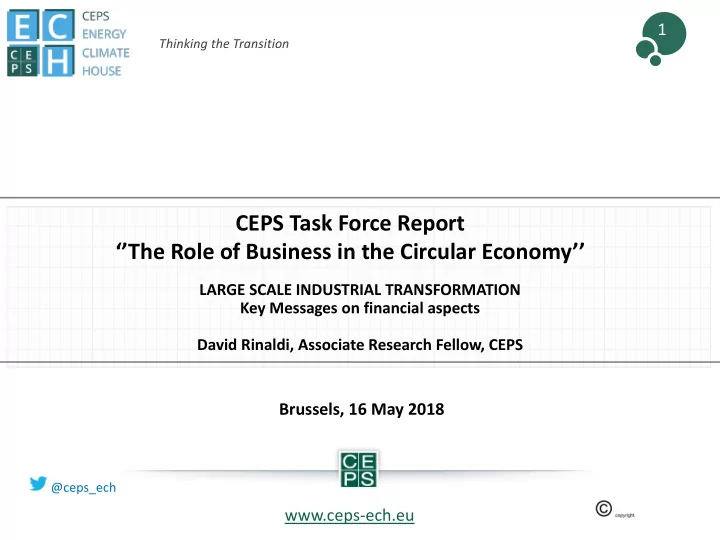

1 Thinking the Transition CEPS Task Force Report ‘’The Role of Business in the Circular Economy’’ LARGE SCALE INDUSTRIAL TRANSFORMATION Key Messages on financial aspects David Rinaldi, Associate Research Fellow, CEPS Brussels, 16 May 2018 @ceps_ech www.ceps-ech.eu
Investment & Finance ce for Industrial Transformation T o seize the opportunities of a circular economy as much as €320 billion should be channelled by 2025 in three circular sectors alone: 1. mobility and transport 2. food industry 3. the built environment Internal Financial Public Resources Intermediaries Investment • More a problem of • Adapting to the new • Support to industrial confidence than risk profile of CE transformation from liquidity models national and EU budgets • Economic prospects • Some have realised are now rosier the potential of CE • Focus on technical advisory
CE CE ch challenges t the f financi cing o of I Industrial R Renewal Product & process innovation Industrial symbiosis, collaborative Product-as-a-service transition models and sharing models >> change in the ownership of the asset >> multiple actors in the value chain >> disruptive innovation • A different and more uncertain cash • High upfront costs for the industrial • High upfront costs for industrial flow dynamic renewal and machine compatibility renewal and new resource-efficient with up- & downstream partners machinery (particularly for product • No asset sales imply no initial inflows to repay manufacturing innovation) • Partial loss of flexibility to respond • Market-related risk, uncertainty to market requests • Technological and operational risk about consumers’ behaviour remains high till project • Cost of capital depends on the • Increasing capital needs to pre-finance implementation creditworthiness of the value chain, clients not only of the borrower: • High market risk due to the • Balance sheet extensions uncertainty about customer • Creditworthiness and reliability of • Maintenance contracts and costs acceptance partners affect the borrower’s risk • Easier reuse and re-manufacturing, • Uncertainty related to the residual • The solidity of the value chain is but of uncertain value value of new products not taken into account as a risk- mitigating factor Can industrial synergies to be a form of guarantee, rather than a source of uncertainty?
EU suppo EU support to indus ndustrial rene newal Through legislation, direct financial support, technical services • No specific earmarking; funds available through a variety of programmes • ESIF, EFSI, COSME, InnovFIN, LIFE, Horizon2020 • Multiple products: grants, loans, equity, quasi-equity, guarantees • Increasing focus on advisory and technical assistance to enhance the • bankability of projects proposals The EU showed commitment and focus on CE developments: • • Revision of the notion of ‘innovation’ to include resource-saving organisational enhancements Circular Economy Finance Support Platform •
Policy Recommendati tions 1. Better Data to Contain Risk (EU, national level & private sector) Establishing a database that facilitates the exchange of information about systemic cross- industry risk and residual values, and supports a better risk assessment of circular business models from the private sector too. 2. CE as horizontal objective (EU level) Set the circular economy as a clear horizontal objective for EU financing, in a way similar to low carbon goals. For instance: • establishing a dedicated thematic objective within European Structural and Investment Funds • including resource efficiency as a key metric to award EU financing, e.g. in the EFSI Scoreboard. 3. Single Point of Entry to ease access (EU & national level) Develop the Circular Bioeconomy Investment Platform as: A large coalition involving as much as possible national and regional promotional banks • A tool to help employing different EU resources/programmes in a structured way • A single point of entry for all circular-bio-related projects •
6 - THANK YOU! - @ceps_ech @rinaldi_david
Recommend
More recommend